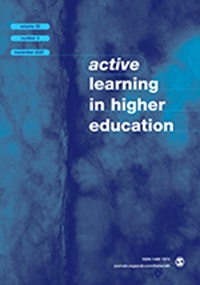利用组织理论改进混合式/翻转式课堂的结构:了解设计选择的影响
IF 3.2
1区 教育学
Q1 EDUCATION & EDUCATIONAL RESEARCH
引用次数: 0
摘要
技术进步和市场压力正在推动教学课程设计方法的发展。通过利用组织设计研究来构建组织和工作流程,以提高有效性和效率,我们重点关注组织设计研究中的两个结构构造:标准化(包括主动学习组件的协调)和集中化(课程实施的决策)。本文研究了在一门课程从传统(面授)向混合/翻转模式转换的过程中,这些结构变化所产生的影响。研究结果表明,在标准化和集中化的基础上构建课程会影响学生在课程中的学习效果。具体而言,从传统讲授法到混合/翻转教学法,学生的短期学习成绩在统计学上没有差异;但是,不同章节的学习成绩差异较小。此外,从学生最后一学期的结业考试中得出的滞后学习效果显示,混合式/翻转式教学法的学生获得了更高的长期学习成绩,这在统计学上是有差异的。我们将此作为新课程结构中标准化主动学习内容有效性的论据。本文章由计算机程序翻译,如有差异,请以英文原文为准。
Using organizational theory components to improve the structure of blended/flipped classes: Understanding the impact of design choices
Technological advancements and market pressures are driving the development of pedagogical course design approaches. By using organizational design research into structuring organizations and work processes to improve effectiveness and efficiency, we focus on two structural constructs from organizational design research: standardization (of coordination including active learning components) and centralization (of decisions making for course implementation). This paper examines the impact of changes to these constructs during the conversion of a course from a traditional (face-to-face) to a blended/flipped modality. Findings show that structuring a course based on standardization and centralization can affect the student outcomes in the course. Specifically, revealing no statistical difference in short-term student performance from the traditional lecture approach to the blended/flipped approach; however, lower variability in performance occurred across sections. In addition, a lagged learning effect derived from an exit exam in students’ last semester, revealed a statistical difference with students from the blended/flipped approach achieving higher long-term learning scores. We offer this as an argument for the effectiveness of the standardized active learning components embedded within the new course structure.
求助全文
通过发布文献求助,成功后即可免费获取论文全文。
去求助
来源期刊

Active Learning in Higher Education
EDUCATION & EDUCATIONAL RESEARCH-
CiteScore
13.20
自引率
12.00%
发文量
31
期刊介绍:
Active Learning in Higher Education is an international, refereed publication for all those who teach and support learning in higher education (HE) and those who undertake or use research into effective learning, teaching and assessment in universities and colleges. The journal is devoted to publishing accounts of research covering all aspects of learning and teaching concerning adults in higher education. Non-discipline specific and non-context/country specific in nature, it comprises accounts of research across all areas of the curriculum; accounts which are relevant to faculty and others involved in learning and teaching in all disciplines, in all countries.
 求助内容:
求助内容: 应助结果提醒方式:
应助结果提醒方式:


